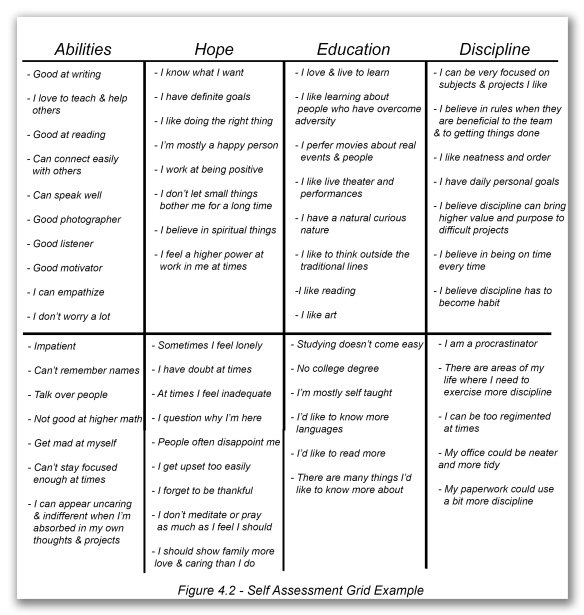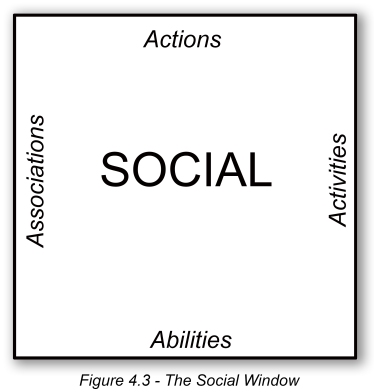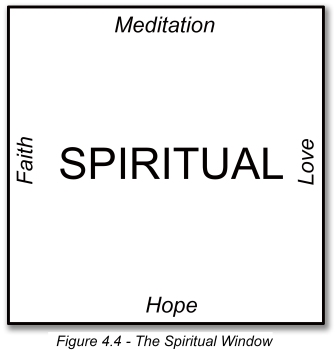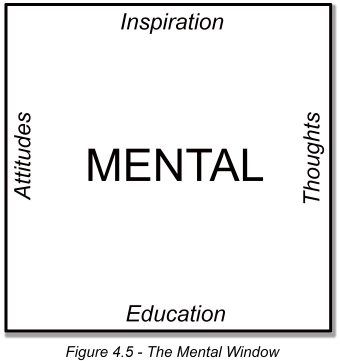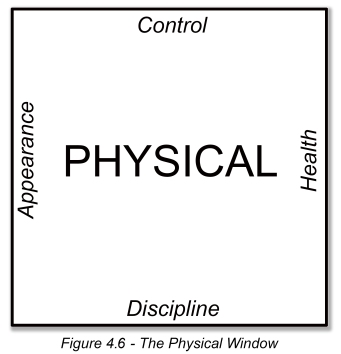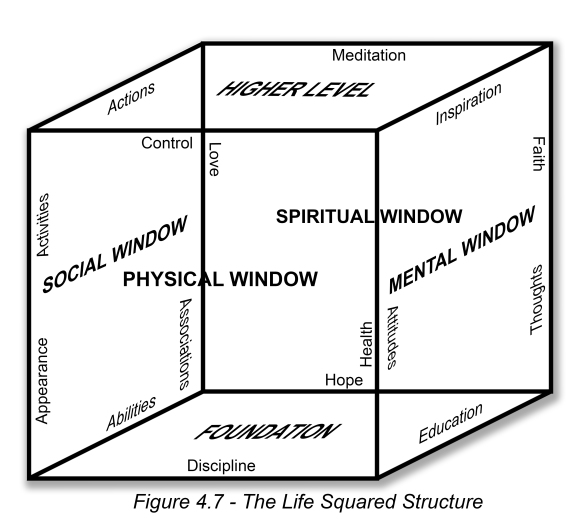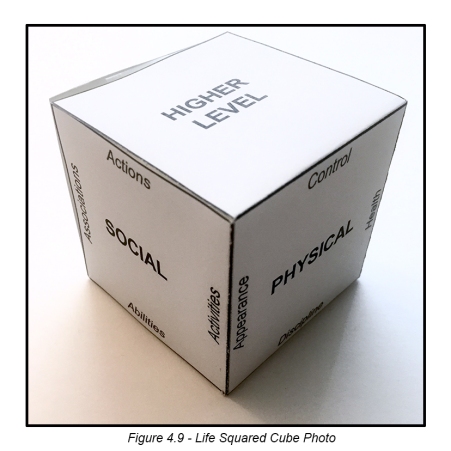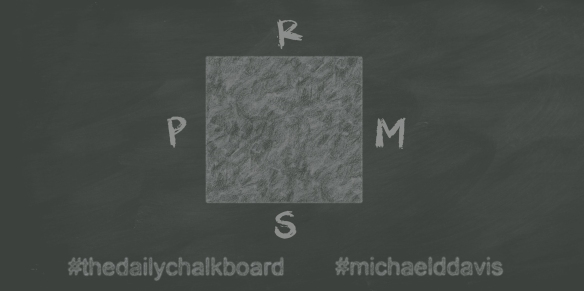
At the end of part 4 of your Life Squared Challenge you were presented with the assignment to think about the window on your Life Squared Structure that is labeled Physical. Here’s that window once again in case you don’t recall what it looks like:
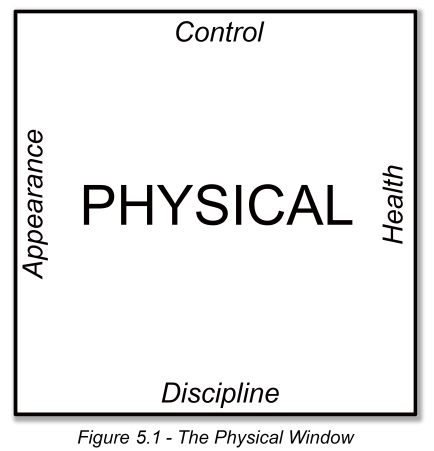
The Physical window is the place you spend most of your time standing in front of either peering out into the world through or looking into with either retro or introspection. Since it’s the window you are likely to be most familiar with, it will be your starting point for the next few challenges to follow.
We are first and foremost physical creatures. Biologically speaking, this is how we tend to relate to the world at large and compare ourselves to other living things and other human beings. For example; we arrive at our work in the morning just like we usually do. There’s nothing unusual about this day but upon being approached by a co-worker or acquaintance we are asked , in what we take to be more than usual curiosity, how we are doing. Most of us think immediately in terms of our mental or emotional condition, but often it’s our physical composure and how we appear to others that bring up the question in our own mind of “How do I feel today? And our immediate response is usually something like, “Oh fine, and you?”
Even as the question is being asked about how we are feeling we begin to quickly take stock of our current physical condition. That’s the reason we ask the question back. It gives us a split second to analyze our situation. “Am I dressed appropriately? Did I remember to put on deodorant? Has the slight limp I’ve developed, brought on by these new tight shoes, been detected? “I really feel like crap because of my lack of sleep and eating supper so late last night, but does it really show that much?” Our physical insecurity mounts and all those things we know we could and should do to physically improve ourselves begin to trickle into our mind.
And it only gets better as an individual, whom we happen to physically admire, catches our eye and we find ourselves momentarily sidetracked as we jealously marvel at their composed, well dressed and relaxed presence. They give us a pleasant smile as they effortlessly glide past, without even the slightest hint of a limp in their step. Our left shoe suddenly seems tighter, our foot hurts worse, and we know inside that we really don’t feel fine at all. “Did I remember to put deodorant on? Another lovely day ahead”, we think, as we limp off to our work, shoulders slumped, self image bruised and most definitely not in the mood to speak with or be seen by anyone for the remainder of the day. The physical flood gates have been opened.
If any of this sounds familiar to you, rest assured that you’re not alone in your insecurity. We are mentally and emotionally assaulted by a barrage of expectations that we not only place on ourselves, but that society in general and the marketplace in particular places on us. Unless we look, smell, act, associate or recreate a certain way, we are deemed not good enough to be counted among our peers. That’s the message anyway, and it’s one that keeps us on the verge of anxiety about our physical well being most of our lives.
Remember that assignment at the end of part 4, where you were asked to think about how you feel about yourself physically? What is your health like? How are your eating habits? Do you get enough rest or exercise? Did you happen to complete that exercise? If not, I encourage you to do so now, because the first thing that we’re going to discuss when it comes to our physical window on the world is discipline. It rests atop your foundation and forms the base and basis for everything to come. It serves as the starting point for changing your life for the better.
When we look at our Physical window we see Discipline at the bottom, Appearance to our left, Health to our right and Control at the top. There’s no randomness to this order. Discipline is at the bottom because it’s where we are going to begin. Control is at the top because it’s our primary goal. We want to Control how we look, how we feel and how others perceive us. Appearance is opposite Health because in order to feel and look good you have to actually be in good health. The way you Control people’s initial perception of you is through your physical Appearance and Health. If you recall from part 4, it’s a sad fact that many people determine whether they are going to like you or not the instant they lay eyes on you. If you want to be in Control of the acceptance by others and influence their perception of you at first glance, then your physical Health and Appearance must be the best they possibly can.
Let’s step back from our window for a moment and take stock of your Appearance and Health. Are there areas you’ve identified, through completing the last exercise that pointed to specific things you can improve? Be realistic with yourself. Start with the most obvious things like eating well, drinking enough water and getting enough exercise and rest. These four basic things; nutrition, water, exercise and rest are the foundation for your physical well being. Without taking a disciplined approach to getting the right amount of each of these, you’ll never feel or be in the best physical condition possible. It can’t be stated any simpler than that.
You can try every diet known to man. You can eat the best organic foods around. You can spend ridiculous amounts of money on personal trainers and gym memberships, but if you don’t have a disciplined approach and attitude towards reaching your goals then it is all for nothing. Discipline is the key to success, period. When you have Discipline you have set into motion a plan for progress towards your personal goals. Without it your life is like a sailing ship without a sail. The winds of opportunity can blow all they want, but if you don’t have the Discipline to raise your sail, you are destined to bob around on an ocean of waves that will carry you up and down but not provide the required momentum to move you forward.
Discipline begins with a plan. Think of this like planning a journey. To begin your journey you must know where your destination is and you have to map out how you will reach that destination. How can you possibly get to where you want to go without knowing how to get there? Deciding where your destination lay is your next challenge, along with creating the map that’s going to get your there.
The destination you are headed towards is a combination of physical Health and Appearance. Let’s call this destination Controlled Presence. Controlled Presence is that place you reach that determines how you appear to others. You will know you’ve arrived when you are viewed in the eyes of others exactly as you intend to be viewed.
Taking the list from part 4 of this challenge you will now put measurable amounts to each of the questions you answered. You can think of these measurable amounts like you think of the distance you must travel to reach your destination. These amounts will be measured in terms of pounds, inches, hours, miles, calories, carbohydrates, or whatever measurement fits reaching your destination goal best.
Let’s take something we are all familiar with. When it comes to our weight we all know this is measured in terms of pounds or kilos. If you know that part of your destination is to either take off or put on a certain amount of weight, then that part of our journey will be measured accordingly. The same with sleep for instance. If you know you are not getting enough rest, then part of your journey will be to determine how many hours you need to get refreshed to adequately continue your journey. Put numbers to your journey so you can plan on how long it will take you to arrive at Controlled Presence.
Physical health, nutrition, sleep and water are four very important and much discussed topics when it comes to improving your health and physical appearance. I’m not going to provide or suggest specific quantities, plans, strategies or methods for attaining success in these areas other than to tell you that whatever you decide to do, it will require Discipline. There are plenty of resources available to help you determine the proper measures you need to get to Controlled Presence. To my knowledge there’s no “one size fits all” plan when it comes to attaining personal goals in Health and Appearance.
It is important for you to know what kind of physical shape you are in at the outset of any plan so I do recommend that you research and discover, on your own, what type of exercise and diet modification is appropriate for you. This is best determined by having a physical checkup performed by a licensed physician and seeking health advice from a trusted medical professional.
The key to a Controlled Presence is determining the numbers for those personal physical challenges you’ve identified and then disciplining yourself to stick to those numbers until you’ve reached your goal. The good news is isn’t as difficult or as hard as it may seem to determine these numbers create a plan. I can tell you from personal experience that once you‘ve disciplined yourself to begin and then stick to the numbers you’ve identified as being in your best interest, physically and otherwise, it gets easier to stick with the plan.
So make a list in your journal, (you are keeping a written journal right?), that looks something like this for each of your Health and Appearance goals:
- Name of Health/Appearance Goal:
- Form of measurement to be used:
- Where I am at this time:
- Where I want to be:
- The current difference between now and my destination of Controlled Presence:
Time frame for reaching my Health/Appearance Goal: Your list might look something like the example below:

When you combine your Physical Goal Roadmap with a calendar to keep track of your progress then you are on your way to creating a disciplined approach to your Controlled Presence. I would recommend an actual physical calendar instead of a digital one. You can then hang this calendar in a place where you will see it every day as a reminder of the distance you have to travel, and even more importantly, the distance you’ve come and the progress you’ve made towards reaching your desired Controlled Presence.
There’s a magical quality to actually seeing the effect your goals are having and the progress you’ve made towards achieving them. Once you begin to see progress, whether it’s in the reduction of a waistline, a better posture, or feeling more rested and fit, you begin to transform yourself into a believer of yourself and that increases self confidence. Once you believe you can accomplish what you set out to do, because of the results you physically see, a natural competitive drive comes in to play and you start to challenge yourself to do even more and become even better. This is the magic of the Life Squared Challenge. Once you truly begin to see results, and to challenge yourself in even greater ways, you will be amazed at what you are able to achieve.
As humans we are meant to push ourselves, to challenge ourselves and each other so we can travel beyond our perceived limits. It may seem unbelievable but there was a time when we could only dream of running a mile in under four minutes. It was impossible. There was a time when ascending into the sky on artificial wings and traveling at incredible speeds was also just a dream. It’s become routine as walking across the street now. Not so many years ago the idea of breaking the bounds of earth’s gravity and travelling to another celestial body orbiting our sun were the things of science fiction. My question to you is “What’s next?” What will you do, improve upon or help achieve in your community or perhaps in the world at large? Challenge yourself now. Make the Life Squared Challenge a habit and discover what incredible things you have to offer mankind.
Your assignment now is to complete your personal Physical Goal Roadmap and in the next part of our Life Squared Challenge we’ll discuss a few stumbling blocks and detours that can potentially slow down your disciplined journey to Controlled Presence.
As always, If you should have questions, comments, concerns or criticisms please don’t hesitate to be in touch. You are welcome to post your comments here or please feel free to email me at michaelddavis@mddastudio.com I’d love to hear from you, good, bad or indifferent
#michaelddavis
“I simply write what I feel, because it matters to me. Hopefully some of it will resonate with and matter to you as well” – MDD
© 2016 by Michael D. Davis – All Rights Reserved – The Life Squared Challenge is copyrighted material and cannot be copied or reproduced for commercial use, in part or in whole, in any printed or electronic form whatsoever, without expressed written permission from the author.


